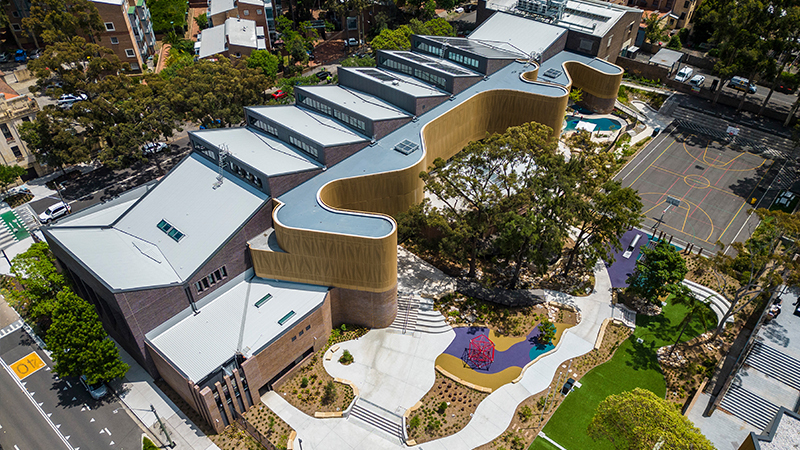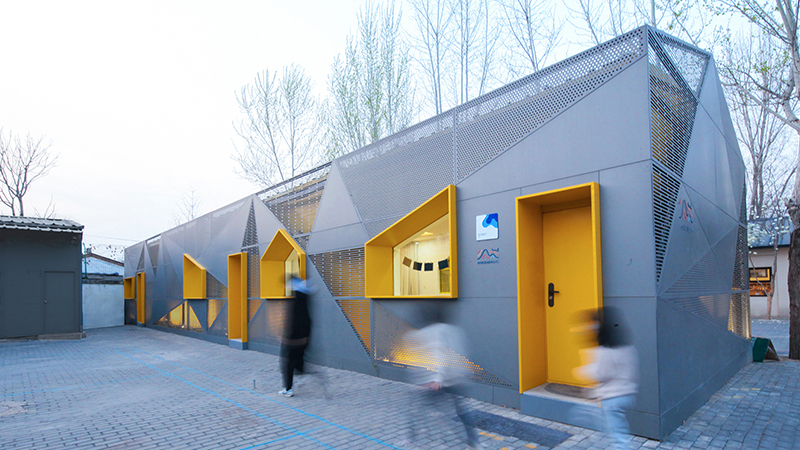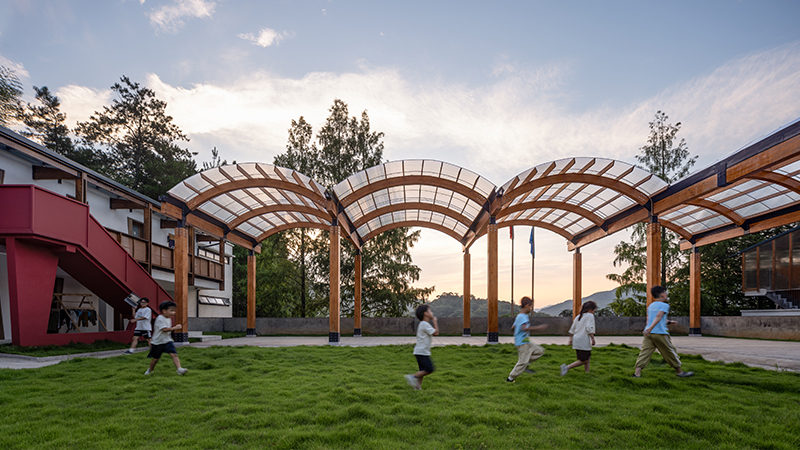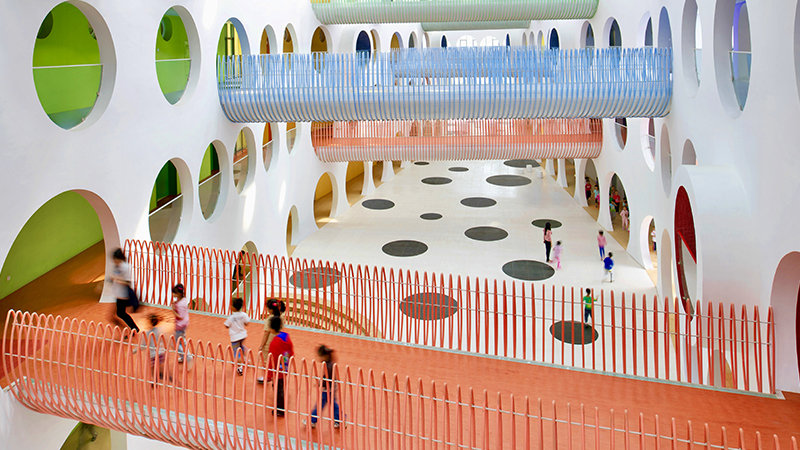| 公司: | ARCHIS(如是)建筑设计事务所 | 类型: | 建筑 |
|---|---|---|---|
| 地区: | 中国 | 标签: | 学校 |
▲连通的报告厅+图书馆
Loop Library and Auditorium
现实世界的背景预设:少年与城市
Designing "World Views": School and the City
为少年设计一所面对未来的职业高中时,ARCHIS (如是) 建筑设计事务所思考着如何创造一个身处其中就可以体会到人生各种可能性的体验式校园。
在宁波市古林职业高级中学设计的校园里,ARCHIS 的设计团队把城市的概念引进到校园空间中,希望用城市性的方法来看待校园的设计。学生作为观众进入时并不知道接下来会发生的故事或看到的场景,所有的故事线和内容都是需要靠学生自我探索的。故事有着开放式结局,不被限定的开始和结束。相较于把校园理解为一栋建筑或一组建筑群,ARCHIS 认为更应关注的是它是否混杂了一种更为复杂的“城市性”在其中。
The open framework of the design invites multi-authored narratives in the creation of an interactive and immersive campus. Students are the directors of their own daily encounters and plot developments on campus, devising their narratives through choosing different paths to take. Instead of imposing a preconceived coherence, the design embraces multi-authorship in the daily use of the school to stimulate the improvisational, the indeterminate, and the multiplicity of meanings.
▲校园的设计可以是设计一个“世界观”
Designing a "World View"
▲校园里面的故事线和内容按照学生的自我探索展开,故事有着开放式结局,不被限定的开始或结束
Storylines and branch developments unfold with the students' exploration and path selection. All stories are open-ended, without a predetermined beginning or ending.
▲制图:如是建筑(Image: ARCHIS)
项目概况
Project Overview
宁波市古林职业高级中学创办于1956年,是一所省级重点、全寄宿制公立学校。项目位于宁波市海曙区,学校总用地面积约96851平方米,学校规模75个班,共3000个学生。
Ningbo Gulin Vocational High School is a new campus that accommodates 3,000 students distributed across 75 classes, spanning four specialized departments: preschool education, culinary arts, arts and crafts, and e-commerce. Situated in Ningbo's Haishu District, China, the project encompasses two distinct plots, with a combined land area of approximately 96,851 square meters.
▲夜景鸟瞰视角
Aerial Night View
▲图书馆
Loop Library
▲行政楼
Executive Building
▲连续的漫游系统
Continuous Loop System
▲食堂
Dining Hall
▲体育馆
Gymnasium
▲球场
Basketball Courts
#01
挑战与机遇
#01
Concept & Challenges
设计一所面对未来的职业高中存在着许多挑战与机遇。职业高中与普通高中的教学模式存在差异。相对于普通高中,职业高中的教育模式和需求更加多样化,不同的专业和功能之间需要建立紧密的联系和相对的独立。因此,学校的交通空间需要被重新思考,以此减轻水平和垂直方向上的交通流量压力,同时促进各个专业的独立性和跨学科的开放性。考虑到未来教学模式的转变,设计时我们也考虑到如何将灵活性设计到学校的4D框架里。
Designing a vocational high school presents a specific set of challenges. In contrast to the conventional classroom layout in general high schools, vocational high schools demand the building of a substantial number of vocational training rooms alongside standard classrooms. Students must navigate between various classrooms in different departments efficiently, necessitating an efficient circulation design on both horizontal and vertical levels to facilitate the intense traffic between diverse areas of specialization and functions. As the pedagogy of the school evolves, designing the school with versatility that can adapt to changing functions, ideologies, and events also becomes crucial.
制图:如是建筑
#02
“千层糕”——毯式建筑的重组叠加
#02
Mille-Feuille : Mat Urbanism and Non-Orthogonal Courtyard
通常校园空间的组织模式采用相互孤立的教学单元围合出开敞空间。这样的空间组织方式经济,但不利于学生之间的交流沟通,且其空间形式单调乏味。在这个项目里,我们通过采用毯式建筑的组织方式,将所有教学单元打散后相互组合叠加,满足职校相对普通高中更复合的功能性需求。复合的功能组织方式和连通的交通能够让师生快速到达他们的目的地,享受便捷有趣的步行体验。
Historically, school designs have adhered to similar layouts dictated by traditional pedagogical models, functional configurations, and stringent regulations governing lighting, ventilation, and acoustics. Conventional campus designs also typically entail isolated teaching units that enclose open spaces, yielding uniform spatial arrangements that hinder student interaction and communication. The traditional, mono-function campus designs cannot adapt to contemporary educational paradigms, which prioritize cross-disciplinary education, informal learning, and experiential pedagogy. Consequently, the conventional architectural approach in educational institutions falls short of accommodating the contemporary vision for education.
The project challenges the traditional notion of an efficient construction system in China, which typically follows an orthogonal 8.4m x 8.4m grid. Instead, we explored alternative spatial configurations using mat courtyard typology in a non-orthogonal grid system. This allows various programs to be interlinked in a more efficient and organic way and offer students and teachers a more convenient pedestrian experience.
制图:如是建筑
在地面层,我们将对采光要求较小的实训教室布置在一个开放式的网络中,以适应多种活动类型,并能够根据未来学校的使用需求进行灵活调整。在二楼和三楼,我们将普通教室模块化地布置在不同的内庭周边,以获得更好的采光和视野。此外,在普通教室和实训用房之间,非正式教学空间的灵活布局将各种活动空间连接在一起,以此促进不同专业之间的交流和不同内庭之间的联系。
On the ground floor, the vocational training rooms with lower lighting requirements are placed in an open framework to accommodate flexible layouts over time. On the second and third floors, standard classrooms are clustered around different inner courtyards to receive optimized lighting and views. Additionally, in between the standard classrooms and vocational training rooms, various informal teaching spaces link various departments together to foster multidisciplinary interaction.
制图:如是建筑
▲鸟瞰视角
Aerial Perspective
#03
“升级通关LOOPS”——非正交体系下的庭院拓扑
#03
"LOOPS" – Non-Orthogonal Courtyard+Mat Topology
在满足产学融合的复杂功能性与学校设计相关规范的前提下,我们试图将建筑与场地的正交体系扭转,使建筑更好的跟场地融合,增加其内部非正式教学空间,并提高整体采光质量。其中工艺美术专业、烹饪专业、园林景观专业、幼儿教育专业、通用教学区、图书馆等多个不同教学空间的内庭,使用了独特的地面铺设、色彩搭配、材料选择、垂直设计元素和空间布局。这些元素就像视觉标识,有助于创造不同的空间体验,帮助学生在校园中自如导航。
By introducing a twist to the conventional orthogonal grid system in the mat+courtyard typology, we integrate the building better with the site, enhancing informal educational spaces and overall lighting quality. The interconnections of the internal courtyards not only improve the efficiency of on-campus traffic but also foster interdisciplinary communication and collaboration. Furthermore, the internal courtyards within various educational spaces are marked by their unique flooring, color palettes, material choices, vertical design elements, and spaces. These elements serve as visual markers and contribute to distinct place-making spatial experiences, helping students find their way around the campus without falling into a monotonous routine.
▲工艺美术专业庭院
Art School Department Courtyard
▲工艺美术专业庭院
Art School Department Courtyard
▲烹饪专业内庭走廊
Cooking School Department Corridor
▲园林景观专业庭院
Landscape Department Courtyard
▲反透视楼梯
Anti-perspectival Staircase
▲幼儿教育专业庭院
Early Education Department Courtyard
▲幼儿教育专业庭院
Early Education Department Courtyard
▲行政楼
Executive Building
▲LOOP图书馆内庭
Loop Library Courtyard
除了庭院本身具有不同特点和功能,非正交的庭院拓扑也提供了多线性的漫游体系和不同主题的教学空间,从而使学校成为容纳多重事件、多重空间、多重场景的载体。
By creating multiple courtyards with diverse attributes and functions, the design constructs a microcosmic city that can enable a multitude of events, spaces, and stories, transforming the traditional closed teaching model into an open and engaging narrative.
▲烹饪专业楼梯间
Cooking School Department Staircase
▲幼儿教育专业楼梯间
Early Education Department Staircase
▲图书馆室内
Loop Library Interior
▲LOOP图书馆室内
Loop Library Interior
#04
“漫游地图”——共享路径体系
#04
Roaming Map: Continuous Loop System
学校的二楼(从景观大台阶到报告厅,再到图书馆及各个教学楼和庭院)由一个共享漫游系统连通。不同的公共空间和室内外空间立体的串联为学生和老师提供了便捷且风雨无阻的交通。半开放的共享长廊和景观内庭使得学生在上下课之余也能感受到季节与天气的变化。
The second level of the school is interconnected through a continuous loop system, enabling covered access from the auditorium, library, and classrooms to the courtyards. Furthermore, all departments within the school are interlinked through courtyards, facilitating cross-disciplinary interactions, and ensuring efficient circulation. Various landscapes, combining water reflecting pool, rooftop gardens, and courtyard gardens, create a diverse learning environment. The continuous loop system connects indoor and outdoor spaces, ensuring all-weather accessibility and enhancing the experience for social activities and informal learning. Shared corridors and landscaped courtyards enable students to experience seasonal changes between classes.
▲开放的剧场舞台:公共的大平台和观景平台
Open Theater: Public Elevated Platform and Viewing Deck
▲空中连桥
Skybridge
▲环形LOOP图书馆
Loop Library
▲连续的大地:从景观大台阶到大平台到24小时开放的外挂楼梯连接的观景平台
Continuous Ground: from Landscaped Staircases to a 24-hour Accessible Viewing Deck
▲报告厅与“泡泡球”天光
Auditorium and Bubble Skylights
▲报告厅室内
Auditorium Interior
#05
“皮肤设定”——立面设计中的秩序与变化
#05
"Skin Configuration" – Order and Variation in Facade Design
毯式建筑连续统一的特点同样体现在了建筑立面上,空间中的关联性与差异性通过建筑立面得以强化。报告厅的波浪穿孔板与教学楼的GRC面板分别都采用了相同样式但三种不同弧度的单元,以可控的随机组合的方式搭建出整体的外墙立面。横向的同材质连续性外立面暗示了内部功能空间的连续,但其中因不同弧度的单元带来的光线反射角度不同,从而产生有着节奏变化的光影律动,如非正式学习空间不同的情境空间的变化。
The building façade reflects both continuity of the campus and differentiation between various functions. The undulating GRC panels of the classrooms and perforated aluminum panels of the auditorium are grouped in various ways to create dynamic façades under different lighting conditions. Each façade incorporates three modular units of various curvatures, carefully arranged in a systematic yet randomized configuration, allowing perceived continuity on the façade with local variations.
▲教学楼三种弧度的GRC组合的光影律动的立面
GRC Panels: Three Modular Units with Different Curvatures
 |  |  |
▲报告厅的波浪穿孔铝板
The Auditorium's Undulating Perforated Aluminum Façade
▲施工中的场地鸟瞰:连续的庭院和主体建筑
Aerial View of the Construction Site: Interconnected Courtyards
▲报告厅及幕墙施工
Auditorium Façade Construction Photograph
模型和项目图纸
Model and Drawings
▲模型照片Model Photograph
▲一层平面图Ground Floor Plan
▲二层平面图Second Floor Plan
▲三层平面图Third Floor Plan
▲剖面图&立面图Sections and Elevations
项目信息
项目名称:宁波市古林职业高级中学
项目地点:中国宁波
阶段:建成
项目时间:2020-2023年
建筑面积:80,000平方米
用地面积:96,851平方米
甲方:宁波市古林职业高级中学、宁波市教育局
功能:图书馆、教学实训楼、综合行政楼、报告厅、食堂、学生宿舍、风雨操场以及田径场、运动场、校门、辅助用房等
项目团队
建筑设计:ARCHIS(如是)建筑设计事务所
公司网址:https://shining-christina-sun.com/
主持建筑师:孙诗宁
主创设计团队:孙诗宁、庞子锐、Yotam Ben-Hur、彭禹州、吴逸青
设计团队:陆迅、李雅伦、任广为、范立鼎、史佳豪、肖馨瑶
合作设计院
欣捷设计院:张浩、陈良君、罗旻、潘一飞、罗鑫、朱田钱、梁慧丽、李凌航、朱远望
庭院内廊共同设计+室内设计:
蘑菇云设计工作室:徐迅君、甘若蓓、张智斌、尤优、薛萌、杨育青
宿舍及体育馆室内部分:沈康X工作室(沈康懿、熊焯之、曾玺锦)
室内施工图:陈伟、何莉媛
景观设计:刘丰、曹聖
幕墙顾问:蒋传星、王军
照明顾问:庞磊
标识设计:张烁设计文化传播(深圳)有限公司
材料:木纹碳镁板、波纹铝板、木纹冲孔铝格栅、吸音涂料、麦卡伦大理石、塑胶地板
摄影:夏至、朱润资
视频:黑像素
LED显示:洲明科技
监控:大华技术
Project Information
Project Name: Ningbo Gulin Vocational High School
Site: Ningbo, China
Stage: Completed
Project Duration: 2020-2023
Building Area: 80,000 square meters
Site Area: 96,851 m²
Client: Ningbo Gulin Vocational High School, Ningbo Education Bureau
Programs: Library, teaching building, executive building, auditorium, dining hall, student dormitories, sports tracks and fields, sports stadium, school gate, and other supporting functions
Project Team
Architectural Design: ARCHIS Design Studio
Company Website:https://shining-christina-sun.com/
Founder and Principal Architect: Shining (Christina) Sun
Lead Design Team: Shining (Christina) Sun, Zirui (Allen) Pang, Yotam Ben-Hur, Yuzhou Peng, Yiqing Wu
Design Team: Xu Lu, Yalun Li, Guangwei Ren, Liding Fan, Jiahao Shi, Xinyao Xiao
Collaboration: Zhejiang Xinjie Construction Co., Ltd. (Hao Zhang, Liangjun Chen, Ming Luo, Yifei Pan, Xin Luo, Tianqian Zhu, Huili Liang, Linghang Li, Yuanwang Zhu)
Courtyard Corridor Co-design and Interior Design: Supercloud Studio: Xunjun Xu, Ruobei Gan, Zhibin Zhang, You You, Meng Xue, Yuqing Yang
Dormitory and Gymnasium Interior Co-design: Kangyi Shen Studio (Kangyi Shen, Zhuozhi Xiong, Xijin Zeng)
Interior Construction Drawing: Wei Chen, Liyuan HeLandscape Design: Feng Liu, Sheng Cao
Facade Consultant: Chuanxing Jiang, Jun Wang
Lighting Design Consultant: Lei Pang
Signage Design: SURE Design
Materials: Wood Grain Magnesium Carbonate Board, Corrugated Aluminum Plate, Wood Grain Perforated Aluminum Grille, Sound Absorbing Coating, Macallen Marble, Plastic Floor
Photography: Xiazhi, Runzi Zhu
Video: Black Station
LED Panel: Unilumin
Monitoring System: Dahua Technology
更新日期:2023-11-28 16:32:50
非常感谢 ARCHIS(如是)建筑设计事务所 带来的精彩项目, 查阅更多Appreciations towards ARCHIS Design Studio for sharing wonderful work on hhlloo. Click to see more works!




























































